IRS AUCTION NOW!
Bid by June 3rd
All of NNT’s imports are of the highest quality. We work closely with our suppliers to ensure that all materials are FSC certified or are at least selectively harvested. Some of the older growth materials cannot be FSC certified due to them being in large stands of natural forest. The older growth material comes from well documented sources that register with local forestry sustainability’s as well as their own government. None of our lumber is harvested via clear cutting.
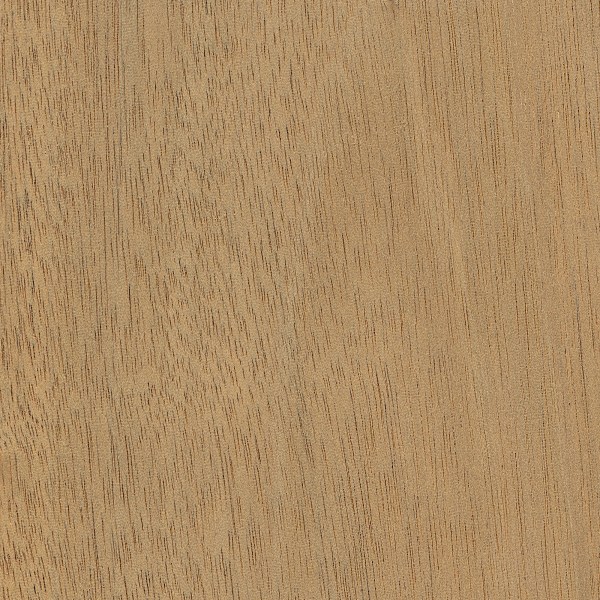
Color/Appearance: Heartwood color can vary a fair amount with Honduran Mahogany, from a pale pinkish brown, to a darker reddish brown. Color tends to darken with age.
Grain/Texture: Has medium to large sized pores, and a medium texture. Grain can be straight, interlocked, irregular or wavy. Mahogany also exhibits an optical phenomenon known as chatoyancy. (See video below.)
Endgrain: Diffuse-porous; medium to large pores in no specific arrangement; solitary and radial multiples of 2-3; mineral deposits occasionally present; growth rings distinct due to marginal parenchyma; rays barely visible without lens; parenchyma banded (marginal), paratracheal parenchyma vasicentric.
Rot Resistance: Considered durable or very durable in regards to decay resistance, though it has been reported as being susceptible to insect attack.
Workability: Typically very easy to work with tools: machines well. (With exception to sections with figured grain, which can tearout or chip during machining.) Slight dulling of cutters can occur. Sands very easily. Turns, glues, stains, and finishes well.
Odor: No characteristic odor.
Sustainability: This wood species is in CITES Appendix II, and is on the IUCN Red List. It is listed as vulnerable due to a population reduction of over 20% in the past three generations, caused by a decline in its natural range, and exploitation.
Common Uses: Furniture, cabinetry, turned objects, veneers, musical instruments, boatbuilding, and carving.
Comments: Honduran Mahogany goes by many names, yet perhaps its most accurate and telling name is Genuine Mahogany. Not to be confused with cheaper imitations, such as Philippine Mahogany, Swietenia macrophylla is what most consider to be the real and true species when referring to “Mahogany.”
An incredibly important commercial timber in Latin America, Honduran Mahogany is now grown extensively on plantations. It has been widely exploited, leading to its inclusion on the CITES Appendix II in 2003. In effect, this limits the international exporting of the lumber to certified sustainable sources. (This is also why many lumber retailers located in the United States are unable to ship Honduran Mahogany outside of the country.) Substitutes sometimes used are African Mahogany or Sapele.
Honduran Mahogany’s easy workability, combined with its beauty and phenomenal stability have made this lumber an enduring favorite.
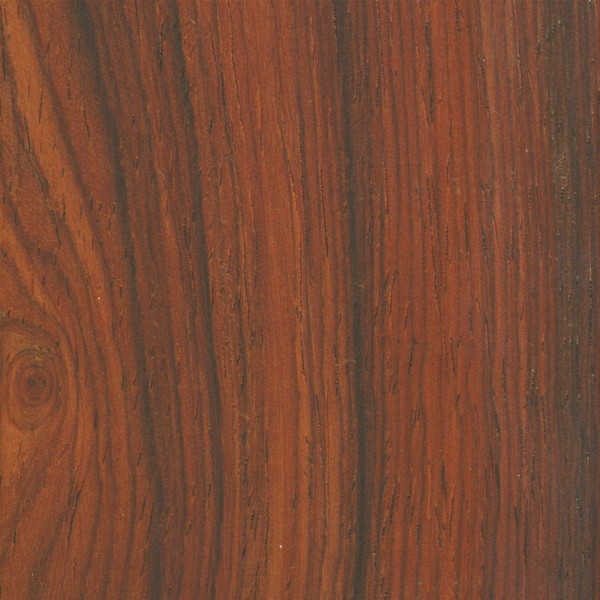
Color/Appearance: Cocobolo can be seen in a kaleidoscope of different colors, ranging from yellow, orange, red, and shades of brown with streaks of black or purple. Sapwood is typically a very pale yellow. Colors are lighter when freshly sanded/cut, and darken with age; for more information, see the article on preventing color changes in exotic woods.
Grain/Texture: Grain is straight to interlocked, with a fine even texture. Good natural luster.
Endgrain: Diffuse-porous; medium to very large pores in no specific arrangement, very few; solitary and radial multiples of 2-3; various mineral deposits occasionally present; parenchyma diffuse-in-aggregates, vasicentric, and marginal; rays narrow, fairly close spacing.
Rot Resistance: Rated as very durable, and also resistant to insect attack. Its natural oils are reported to give it good resistance to degrade from wet/dry cycles.
Workability: Due to the high oil content found in this wood, it can occasionally cause problems with gluing. Also, the wood’s color can bleed into surrounding wood when applying a finish, so care must be taken on the initial seal coats not to smear the wood’s color/oils into surrounding areas. Tearout can occur during planing if interlocked grain is present; the wood also has a moderate blunting effect on cutting edges/tools due to its high density. Cocobolo has excellent turning properties.
Odor: Cocobolo has a distinct spice-like scent when being worked, which some find unpleasant: though it has been used in at least one women’s perfume.
Sustainability: This wood species is in CITES Appendix II, and is on the IUCN Red List. It is listed as vulnerable due to a population reduction of over 20% in the past three generations, caused by a decline in its natural range, and exploitation.
Common Uses: Fine furniture, musical instruments, turnings, and other small specialty objects.
Comments: One of today’s most prized lumbers for its outstanding color and figure; yet also one of the most infamous for its difficulty in gluing, and its tendency to cause allergic reactions in woodworkers.
Also, there are a few misleading reports of Cocobolo’s Janka hardness being only about 1,100 lbf, and it’s modulus of elasticity at only about 1,100,000 lbf/in2: which is almost certainly either a typo or a different wood than what is commonly called Cocobolo (Dalbergia retusa). Reports indicate that Cocobolo is stronger and denser than Brazilian Rosewood, and that is the basis for the strength values (bending strength and modulus of elasticity) that are quoted at the top of this page.
Specific gravity is used to predict the hardness of wood with a fair degree of accuracy, and given its incredibly high density, (it sinks in water: see video below), Cocobolo’s hardness (and other strength properties) is most likely several times higher than the 1,100 lbf which is sometimes reported.
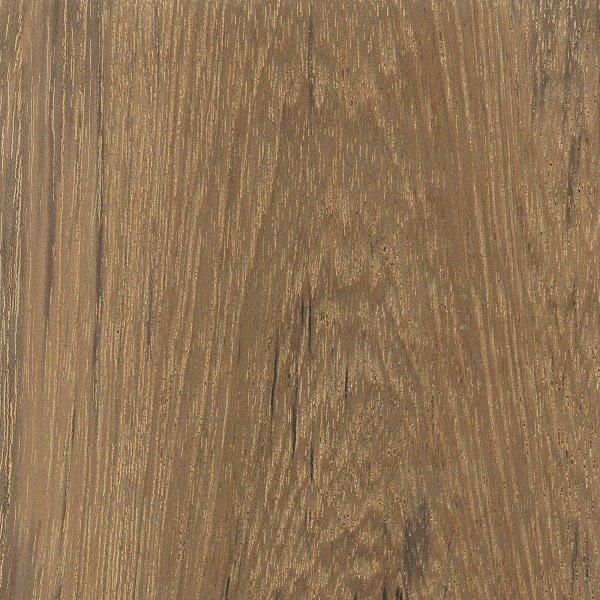
Color/Appearance: Heartwood tends to be a golden or medium brown, with color darkening with age.
Grain/Texture: Teak has a coarse texture with medium-sized open pores. The grain tends to be straight, though it can occasionally be wavy or interlocked. Teak also has a slightly oily or greasy feel due to its natural oils.
Endgrain: Ring-porous or semi-ring-porous; large, solitary earlywood pores, medium-small latewood pores solitary and in radial multiples of 2-3; tyloses and other mineral deposits common; growth rings distinct due to uniseriate row of earlywood pores; rays visible without lens; parenchyma banded (marginal), with bands sometimes wide enough to enclose entire earlywood pores, paratracheal parenchyma vasicentric.
Rot Resistance: Teak has been considered by many to be the gold standard for decay resistance, and its heartwood is rated as very durable. Teak is also resistant to termites, though it is only moderately resistant to marine borers and powder post beetles.
Workability: Easy to work in nearly all regards, with the only caveat being that Teak contains a high level of silica (up to 1.4%) which has a pronounced blunting effect on cutting edges. Despite its natural oils, Teak usually glues and finishes well, though in some instances it may be necessary to wipe the surface of the wood with a solvent prior to gluing/finishing to reduce the natural oils on the surface of the wood.
Odor: Teak can have a leather-like scent when freshly milled.
Sustainability: This wood species is not listed in the CITES Appendices or on the IUCN Red List of Threatened Species.
Common Uses: Ship and boatbuilding, veneer, furniture, exterior construction, carving, turnings, and other small wood objects.
Comments: Used extensively in India and within its natural range for centuries, Teak has grown into a worldwide favorite. With its superb stability, good strength properties, easy workability—and most of all, its outstanding resistance to decay and rot—it’s no wonder that Teak ranks among the most desired lumbers in the world.
Much like the many names and knockoffs of Mahogany, the moniker “Teak” has been affixed and assigned to a number of different woods seeking acclaim. The usual procedure is to take a wood bearing any degree of resemblance to Teak and insert a geographical location in front of the name. For instance, Cumaru is sometimes referred to as Brazilian Teak, while Rhodesian Teak bears little botanical relation to real Teak—Tectona grandis. The name Burmese Teak, however, does refer to genuine Teak.
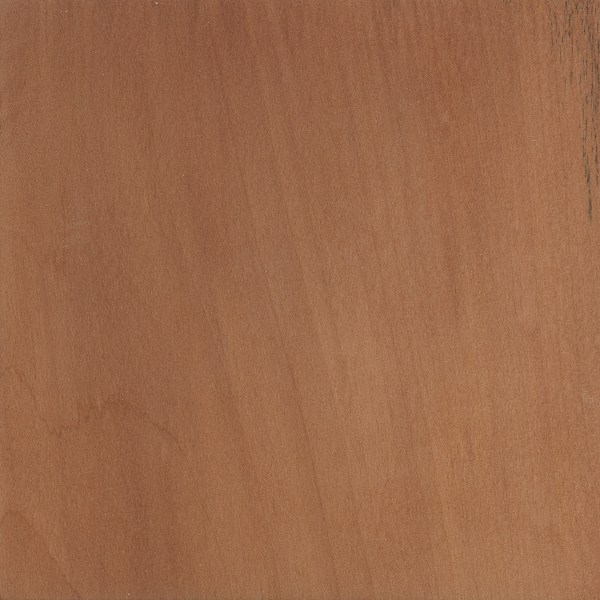
Color/Appearance: Heartwood is a pale pink or light reddish brown. Sapwood is slightly paler but is not usually distinct from heartwood. Pear is sometimes steamed to deepen the pink coloration. Pear is also occasionally dyed black and used as a substitute for ebony.
Grain/Texture: Grain is usually straight, with a very fine uniform texture.
Endgrain: Diffuse-porous; very small pores in no specific arrangement (very numerous); exclusively solitary; heartwood mineral/gum deposits (reddish brown) occasionally present; growth rings distinct; rays not visible without lens; parenchyma not clearly observable with hand lens.
Rot Resistance: Rated as non-durable regarding decay resistance.
Workability: Overall easy to work with both hand and machine tools. Turns, glues, and finishes well.
Odor: No characteristic odor.
Sustainability: This wood species is not listed in the CITES Appendices or on the IUCN Red List of Threatened Species.
Common Uses: Veneer, architectural millwork, marquetry, inlay, carving, musical instruments, furniture, cabinetry, and turned objects.
Comments: It’s been said that Pear is used in Europe much in the same way that Black Cherry is used in the United States: as a popular and high-quality domestic hardwood.
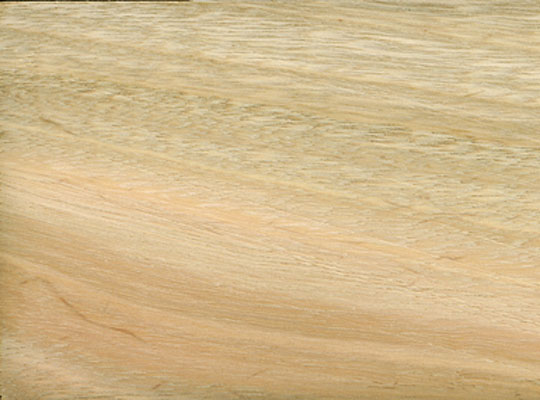
The heartwood is pale yellow or pink, and is not clearly demarcated from the sapwood. The grain is usually straight, texture coarse. The density is 670–940 kg/m³ at 12% moisture content. The wood is difficult to dry without degrade, because it tends to check and warp, but proper stacking can reduce this tendency to a minimum. Strong collapse may occur, but reconditioning by steaming is possible. The rates of shrinkage from green to oven dry are high: 5.2–13.0% radial and 9.7–31.0% tangential.
The wood is tough, hard and moderately strong to strong. At 12% moisture content the modulus of rupture is (106–)140–183 N/mm², modulus of elasticity 11,500–17,800 N/mm², compression parallel to grain (47–)63–76 N/mm², shear 8–11 N/mm², cleavage 14–27 N/mm and Chalais-Meudon side hardness 6.0–7.8. Once dried, the wood is not stable in service.
The wood is fairly difficult to saw and plane, but African plantation trees give much better quality sawn wood than Australian native trees. Quartersawing is recommended. The wood may split on nailing and screwing, and pre-boring is recommended. The wood is not durable, being susceptible to attacks by termites and marine borers. The sapwood is susceptible to Lyctus borers. The heartwood is extremely resistant to impregnation with preservatives, the sapwood is permeable to moderately resistant.
Eucalyptus viminalis is considered to have potential to become more important as a source of pulp for paper making. Wood from 10-year-old trees from Australia had fibres 0.83 mm long, with a diameter of 20 μm. The wood contained 44% cellulose, 22% glucuronoxylan and 29% lignin. A bleached kraft pulp yield of 54% was obtained, with 3.8 m³ wood needed to obtain 1 t of bleached pulp. Compared to pulps from Eucalyptus globulus Labill. and Eucalyptus grandis W.Hill ex Maiden, which are currently the main sources of Eucalyptus pulpwood, pulp from Eucalyptus viminalis had a high strength, high opacity and low porosity, making it especially suited for wood free printing and writing papers and specialty papers.
In Ethiopia leaves yield 0.8% essential oil, with as main components 1,8-cineole (50.9%), α-pinene (28.2%), globulol (5.1%) and limonene (4.3%). The leaves of Brazilian trees contain 1.3–1.8% essential oil, with 1,8-cineole (84–87%) as main component. The essential oil content is highest in the summer season, when temperature and humidity are high.

Angelim Pedra is found in South America, primarily in Brazil and Guyane. The heartwood has a beautiful rich color; varying from a light orange tan to orange brown with brown vertical stripes. The sapwood is a creamy gray color.
Properties: Angelim Pedra is easy to work with both hand and machine tools and can attain a smooth finish
Uses: Because of its durability, Angelim Pedra is popular for making decking, flooring and is used in building construction. It is also a desirable wood for fine furniture making especially when wide widths are needed.

Color/Appearance: The heartwood is a light brown color, though darker shades can also be seen, which is sometimes sold as Olive Ash.
Grain/Texture: Has a medium to coarse texture similar to oak. The grain is almost always straight and regular, though sometimes curly or figured boards can be found.
Endgrain: Ring-porous; large earlywood pores 2-4 rows wide, small latewood pores solitary and radial multiples of 2-3; tyloses common; growth rings distinct; rays barely visible without lens; parenchyma banded (marginal), paratracheal parenchyma around latewood pores vasicentric, aliform, and confluent.
Rot Resistance: Heartwood is rated as perishable, or only slightly durable in regard to decay. Ash is also not resistant to insect attack.
Workability: Produces good results with hand or machine tools. Responds well to steam bending. Glues, stains, and finishes well.
Odor: Gives off a distinct, moderately unpleasant smell when being worked.
Sustainability: This wood species is not listed in the CITES Appendices or on the IUCN Red List of Threatened Species.
Common Uses: Flooring, millwork, boxes/crates, baseball bats, and other turned objects such as tool handles.
Comments: European Ash has fairly good strength properties for its weight, and is also shock resistant.
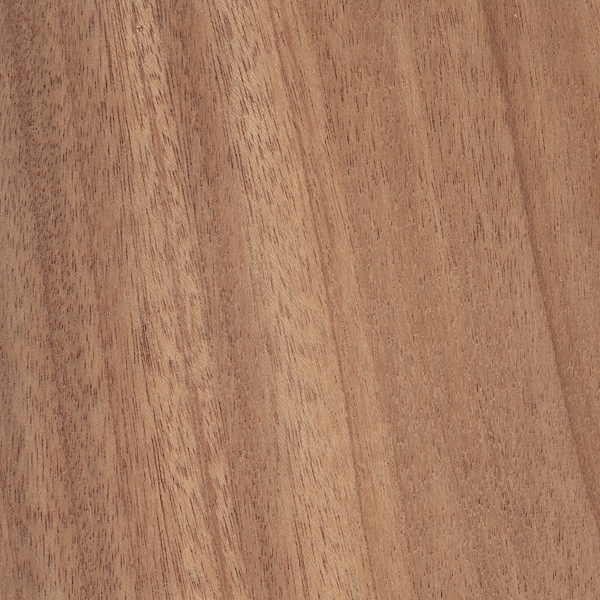
Color/Appearance: Heartwood color is variable, ranging from a very pale pink to a deeper reddish brown, sometimes with streaks of medium to dark reddish brown. Color tends to darken with age. Quartersawn surfaces can also exhibit a ribbon-stripe appearance.
Grain/Texture: Grain is straight to interlocked, with a medium to coarse texture. Good natural luster with a light-refracting optical phenomenon known as chatoyancy.
Endgrain: Diffuse-porous; large to very large pores, very few; solitary and radial multiples; orange/brown deposits occasionally present; growth rings usually indistinct, though sometimes distinct due to terminal parenchyma; rays medium to wide, fairly close spacing; parenchyma scanty to vasicentric, and occasionally marginal (not typical forKhaya spp.).
Rot Resistance: Rated as moderately durable; moderate to poor insect/borer resistance.
Workability: Easy to work, glue, and finish. Tearout can sometimes be a problem if the grain is interlocked.
Odor: No characteristic odor.
Allergies/Toxicity: Although severe reactions are quite uncommon, African Mahogany has been reported as asensitizer. Usually most common reactions simply include eye and skin irritation. See the articles Wood Allergies and Toxicity and Wood Dust Safety for more information.
Comments: Comprised of a handful of species from the Khaya genus, all of which are native to Africa. Sometimes lacks the deeper reddish brown color and durability that is common for true mahogany in the Swietenia genus. Botanically, Khaya is a part of the Meliaceæ family, which not only includes mahoganies, but also Sapele(Entandrophragma cylindricum), and a host of other commercial species. Considered to be a valid substitute forHonduran Mahogany (Swietenia macrophylla), otherwise known as “Genuine Mahogany.”
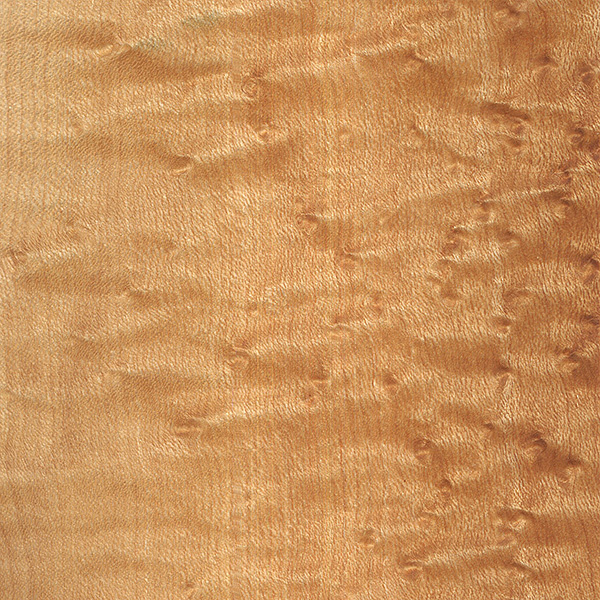
Birdseye Maple is not technically a distinct species of Maple, but rather, it’s a figure that’s occasionally found in Acer saccharum (Sugar Maple) trees. It’s named “birdseye” (sometimes simply written out as: Bird’s Eye Maple) because the figure resembles small bird’s eyes. The figure is reportedly caused by unfavorable growing conditions for the tree. The Sugar Maple attempts to start numerous new buds to get more sunlight, but with poor growing conditions the new shoots are aborted, and afterward a number of tiny knots remain. Birdseye Maple is frequently sold in veneer form, but solid lumber is available as well. Being tiny knots, the birdseye figure is most noticeable and pronounced on flatsawn pieces of lumber.
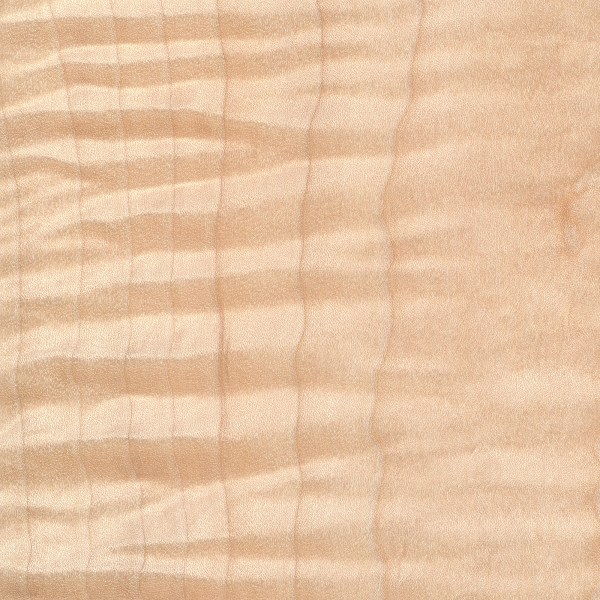
Curly Maple is not actually a species, but simply a description of a figure in the grain—it occurs most often in soft maples, but is also seen in hard maples. It is so called because the ripples in the grain pattern create a three dimensional effect that appears as if the grain has “curled” along the length of the board. Other names for this phenomenon are: tiger maple, fiddleback maple, (in reference to curly maple’s historic use for the backs and sides of violins), or flamed maple. Unlike quilted maple, curly maple is most pronounced when the board is quartersawn, and the curls usually become much less pronounced or absent in flatsawn boards. Hence, on wide boards where the grain tends to be close to vertical (quartersawn) near the edges and horizontal (flatsawn) in the center, the curly pattern will be most evident on the edges of the board, with the figure diminishing in the center. It is not completely clear what environmental conditions (if any) cause this phenomenon, but there are different grades of curly maple, which greatly affect its price. Ideally, the criteria for determining value is based upon: color (both uniformity and lightness—whiter is preferred), frequency of the curls (tight, closely-spaced curls are preferred), and intensity (more depth is preferred). Prices can range from just slightly more expensive than regular soft maple for lower grades of curly maple, to triple, quadruple, or higher for prices of the highest grades. But in general, higher grades of curly maple tend to be less expensive than quilted maple, and offer an economical solution for a “figured” hardwood.

Fumed Oak is not actually a species of oak, but simply is a wood finishing process that darkens wood and brings out the grain pattern. It consists of exposing the wood to fumes from a strong aqueous solution of ammonium hydroxide which reacts with the tannins in the wood. The process works best on white oak because of the high tannin content of this wood. Fumed oak is also called smoked oak. Other species may also be fumed, but usually will not darken as much as white oak.
Color/Appearance: Has a medium yellowish-brown color, though there can be a fair amount of variation in color.
Grain/Texture: Has medium-to-large pores and a fairly coarse grain. May have irregular or interlocked grain depending on growing conditions of the tree.
Endgrain: Diffuse-porous; large to very large pores, very few; solitary and radial multiples; orange/brown deposits occasionally present; growth rings usually indistinct, though sometimes distinct due to terminal parenchyma; rays medium to wide, fairly close spacing; parenchyma scanty to vasicentric, and occasionally marginal (not typical forKhaya spp.).
Rot Resistance: Sessile Oak has been rated as having very good resistance to decay, and is commonly used in boatbuilding applications.
Workability: Easy to glue, and takes stain and finishes very well.
Odor: Has a tell-tale smell that is common to most oaks. Most find it appealing.
Sustainability: This wood species is not listed in the CITES Appendices or on the IUCN Red List of Threatened Species.
Common Uses: Cabinetry, furniture, interior trim, flooring, boatbuilding, barrels, and veneer.
Comments:Sessile Oak falls into the white oak group, and shares many of the same traits as White Oak (Quercus alba). The species is nearly identical to English Oak (Quercus robor), and is used extensively for both interior and exterior building applications throughout Europe.
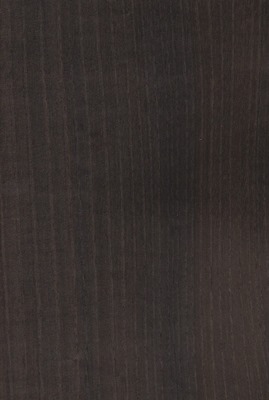
Fumed Chestnut is not actually a species of Chestnut, but simply is a wood finishing process that darkens wood and brings out the grain pattern. It consists of exposing the wood to fumes from a strong aqueous solution of ammonium hydroxide which reacts with the tannins in the wood. The process works great on Chestnut because of the high tannin content of this wood. Fumed Chestnut is sometimes called smoked Chestnut. Other species may also be fumed, but not all will not achieve that rich darkened color like the Chestnut.
Color/Appearance: Heartwood is a light to medium brown, darkening to a reddish brown with age. Narrow sapwood is well-defined and is pale white to light brown.
Grain/Texture: Grain is straight to spiral or interlocked. With a coarse, uneven texture.
Endgrain: Ring-porous; 2-4 rows of large, exclusively solitary earlywood pores, numerous small latewood pores in dendritic arrangement; tyloses common; growth rings distinct; rays not visible without lens; apotracheal parenchyma diffuse-in-aggregates (short lines between rays).
Rot Resistance: Rated as durable to very durable, though susceptible to insect attack.
Workability: Overall easy to work with both hand and machine tools. Chestnut splits easily, so care must be taken in nailing and screwing the wood. Due to its coarse texture, turning is mediocre. Glues, stains, and finishes well.
Odor: No characteristic odor.
Sustainability: This wood species is not listed in the CITES Appendices or on the IUCN Red List of Threatened Species.
Common Uses: Furniture, veneer, and carvings.
Comments: This tree is widely cultivated for the edible seeds which it produces.

Color/Appearance: Heartwood is a relatively uniform light pinkish to reddish brown; colors tend to darken with age. Random pockets of gum and natural oils are commonly present. Grain patterning and figure tends to be somewhat bland.
Grain/Texture: Grain is straight or shallowly interlocked. Medium texture and moderate natural luster.
Endgrain: Can range from ring-porous to diffuse-porous; medium-large earlywood pores, small-medium latewood pores; solitary and radial multiples of 2-3; mineral deposits (red gum) occasionally present; growth rings distinct due to terminal parenchyma in diffuse-porous samples, or lines of larger pores in ring-porous samples; rays usually visible without lens; parenchyma banded (terminal), apotracheal parenchyma diffuse-in-aggregates, paratracheal parenchyma vasicentric.
Rot Resistance: Spanish Cedar ranges from durable to moderately durable regarding decay resistance, and is also resistant to termite attack; the wood is also reported to have excellent weathering characteristics. Older, slower-growing trees from the wild tend to produce wood that is more durable than wood from younger, plantation-grown trees.
Workability: Spanish Cedar is easy to work with both hand and machine tools. However, due to its low density and softness, Spanish Cedar tends to leave fuzzy surfaces if not machined with sharp cutters; extra sanding up to finer grits may be required to obtain a smooth wood surface. Also, natural gum pockets can remain wet and may ooze out onto the surrounding surface, which can clog and gum up saw blades, and make finishing the wood a challenge.
Odor: Has a distinct, lingering, cedar-like scent; this characteristic of the wood makes it a favorite for cigar boxes.
Common Uses: Veneer, plywood, cabinetry, musical instruments, (flamenco and classical guitars), humidors, and boatbuilding.
Comments: A historically valuable Latin-American timber, Spanish Cedar has been exploited in many regions, and the species is now considered to be vulnerable according to the IUCN. It’s also listed on the CITES Appendix III for the countries of Brazil, Bolivia, Columbia, Guatemala, and Peru. (It’s listing in Appendix III simply means that the countries listed have voluntarily chosen to control the exporting of the wood, and have sought the cooperation of other countries to help in enforcing these restrictions.) Spanish Cedar may still be freely exported from other Latin American countries not listed in Appendix III. Not a true cedar, Spanish Cedar is actually more closely related to true Mahoganies (Swietenia and Khaya genera), as both are in the Meliaceae family. Density and mechanical properties can vary widely depending on country of origin and growing conditions; (specific gravity can vary from .30 to as high as .60 in some instances). Some of the wood available at present comes from plantations: where younger, faster-growing trees, produce wood that is lower in density, and paler in color than wood cut from trees taken from forests in the wild.
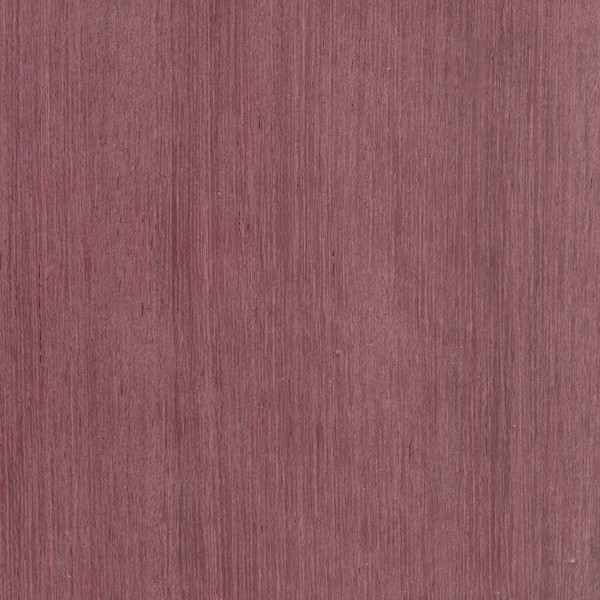
Color/Appearance: When freshly cut the heartwood of Purpleheart is a dull grayish/purplish brown. Upon exposure the wood becomes a deeper eggplant purple. With further age and exposure to UV light, the wood becomes a dark brown with a hint of purple. This color-shift can be slowed and minimized by using a UV inhibiting finish on the wood. For more information, see the article Preventing Color Changes in Exotic Woods.
Grain/Texture: The grain is usually straight, but can also be wavy or irregular. Has a medium texture with good natural luster.
Endgrain: Diffuse-porous; medium to large pores, few; solitary and radial multiples; mineral deposits occasionally present; growth rings may be either distinct or indistinct depending on species and growing conditions; medium rays barely visible without lens, normal spacing; parenchyma winged, lozenge, confluent, unilateral, and occasionally marginal.
Rot Resistance: Purpleheart is rated as being very durable, and resists both decay and most insect attacks, though it has been reported to be susceptible to attack from marine borers.
Workability: Working with Purpleheart can present some unique challenges: if the wood is heated with dull tools, or if cutter speeds are too high, Purpleheart will exude a gummy resin that can clog tools and complicate the machining process. Depending on the grain orientation, can be difficult to plane without tearout. Purpleheart also has a moderate dulling effect on cutters.
Odor: Varies depending upon the species: most species have no characteristic odor, though some species can have a pungent scent.
Sustainability: This wood species is not listed in the CITES Appendices or on the IUCN Red List of Threatened Species.
Common Uses: Inlays/accent pieces, flooring, furniture, boatbuilding, heavy construction, and a variety of specialty wood items.
Comments: Sometimes called Amaranth, this colorful Latin American hardwood is tremendously popular for furniture and other designs that call for a unique splash of color. In addition to its coloration, Purpleheart has excellent strength properties, and can be used in applications where strength is important—a wood for both form and function.
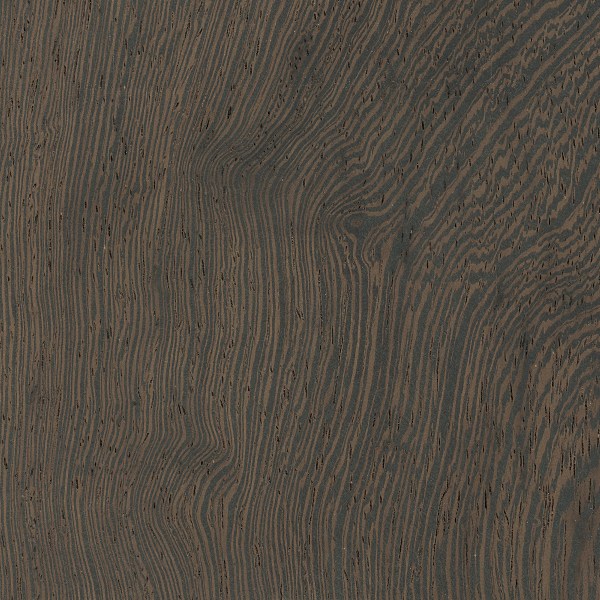
Color/Appearance: Heartwood is medium brown, sometimes with a reddish or yellowish hue, with nearly black streaks. Upon application of a wood finish (particularly an oil finish) the wood can become nearly black.
Grain/Texture: Grain is straight, with a very coarse texture. Low natural luster.
Endgrain: Diffuse-porous; large to very large pores in no specific arrangement, very few; solitary and radial multiples of 2-3; dark brown mineral deposits occasionally present; medium rays not visible without lens, normal spacing; parenchyma vasicentric, confluent, with wide bands of parenchyma typically as thick as the pores.
Rot Resistance: Very durable, and resistant to termite attack.
Workability: Can be difficult to work with hand and machine tools. Blunts tool edges. Sands unevenly due to differences in density between light and dark areas. Very splintery—care must be used when handling unfinished wood with bare hands, as splinters have an increased risk of infection. Very large pores can be difficult to fill if a perfectly smooth/level finish is desired.
Odor: Wenge has a faint, slightly bitter scent when being worked.
Sustainability: This wood species is not listed in the CITES Appendices, but is on the IUCN Red List. It is listed as endangered due to a population reduction of over 50% in the past three generations, caused by a decline in its natural range, and exploitation.
Common Uses: Veneer, paneling, furniture, turned objects, and musical instruments.
Comments: Usually pronounced WHEN-gii or WHEN-ghay, the wood has excellent strength and hardness properties, and is also dark enough to be used as a substitute for ebony.

Color/Appearance: Has a very conspicuous flecking that gives this wood its namesake. The wood itself is a reddish brown with grey or light brown rays, which result in a lace pattern when quartersawn. Like other woods that exhibit the strongest figure in quartersawn pieces, (such as Sycamore), Lacewood has the most pronounced figure and displays the largest flecks when perfectly quartersawn; this is due to the wood’s wide medullary rays, whose layout can be seen the clearest when looking at the endgrain.
Grain/Texture: Has a fairly coarse and uneven texture due to the difference in densities between the regular wood tissue and the rays. The grain is usually straight.
Endgrain: Diffuse-porous; small to medium pores in tangential rows; solitary and tangential multiples of 2-3; deposits in heartwood occasionally present; growth rings indistinct; very wide rays easily visible without lens; parenchyma banded, diffuse-in-aggregates.
Rot Resistance: Lacewood is rated as non-durable and is also susceptible to insect attack.
Workability: Overall a fairly easy wood to work with, taking glues, stains, and finishes well; though there may be some difficulty in planing, with tearout occurring. Some species of lacewood can also have a moderate blunting effect on cutting edges.
Odor: No characteristic odor.
Sustainability: This wood species is not listed in the CITES Appendices or on the IUCN Red List of Threatened Species.
Common Uses: Veneer, cabinetry, fine furniture, musical instruments (guitars), and turned objects.
Comments: The name “Lacewood” is used very loosely and can be applied (and misapplied) to a number of different wood species. In its vaguest sense, the term “lacewood” is used to describe any wood that displays figuring that resembles lace. Attempts to identify a specific board macroscopically may be difficult. Two Australian species, Northern Silky Oak (Cardwellia sublimis), and Southern Silky Oak (Grevillea robusta) can both look very similar, and are sometimes sold as Australian Lacewood. Additionally, Leopardwood (Roupala spp.) looks similar, but tends to be slightly darker brown, and is significantly heavier.